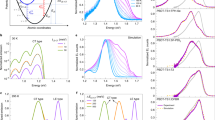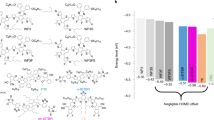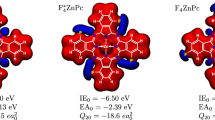Abstract
Organic solar cells demonstrate external quantum efficiencies and fill factors approaching those of conventional photovoltaic technologies. However, as compared with the optical gap of the absorber materials, their open-circuit voltage is much lower, largely due to the presence of significant non-radiative recombination. Here, we study a large data set of published and new material combinations and find that non-radiative voltage losses decrease with increasing charge-transfer-state energies. This observation is explained by considering non-radiative charge-transfer-state decay as electron transfer in the Marcus inverted regime, being facilitated by a common skeletal molecular vibrational mode. Our results suggest an intrinsic link between non-radiative voltage losses and electron-vibration coupling, indicating that these losses are unavoidable. Accordingly, the theoretical upper limit for the power conversion efficiency of single-junction organic solar cells would be reduced to about 25.5% and the optimal optical gap increases to 1.45–1.65 eV, that is, 0.2–0.3 eV higher than for technologies with minimized non-radiative voltage losses.
This is a preview of subscription content, access via your institution
Access options
Access Nature and 54 other Nature Portfolio journals
Get Nature+, our best-value online-access subscription
$29.99 / 30 days
cancel any time
Subscribe to this journal
Receive 12 digital issues and online access to articles
$119.00 per year
only $9.92 per issue
Buy this article
- Purchase on Springer Link
- Instant access to full article PDF
Prices may be subject to local taxes which are calculated during checkout



Similar content being viewed by others
References
Park, S. H. et al. Bulk heterojunction solar cells with internal quantum efficiency approaching 100%. Nat. Photon. 3, 297–303 (2009).
Liu, Y. et al. Aggregation and morphology control enables multiple cases of high-efficiency polymer solar cells. Nat. Commun. 5, 5293 (2014).
Guo, X. et al. Polymer solar cells with enhanced fill factors. Nat. Photon. 7, 825–833 (2013).
Zhao, J. et al. Efficient organic solar cells processed from hydrocarbon solvents. Nat. Energy 1, 15027 (2016).
Green, M. A. Radiative efficiency of state-of-the-art photovoltaic cells. Prog. Photovolt. 20, 472–476 (2012).
Tvingstedt, K. et al. Radiative efficiency of lead iodide based perovskite solar cells. Sci. Rep. 4, 6071 (2014).
Würfel, P. Physics of Solar Cells: From Basic Principles to Advanced Concepts 2nd edn (Wiley-VCH, 2009).
Queisser, H. J. Detailed balance limit for solar cell efficiency. Mater. Sci. Eng. B 159–160, 322–328 (2009).
Vandewal, K., Tvingstedt, K., Gadisa, A., Inganäs, O. & Manca, J. V. Relating the open-circuit voltage to interface molecular properties of donor:acceptor bulk heterojunction solar cells. Phys. Rev. B 81, 125204 (2010).
Tvingstedt, K. & Deibel, C. Temperature dependence of ideality factors in organic solar cells and the relation to radiative efficiency. Adv. Energy Mater. 6, 1502230 (2016).
Ran, N. A. et al. Harvesting the full potential of photons with organic solar cells. Adv. Mater. 28, 1482–1488 (2016).
Liu, J. et al. Fast charge separation in a non-fullerene organic solar cell with a small driving force. Nat. Energy 1, 16089 (2016).
Vandewal, K. et al. Quantification of quantum efficiency and energy losses in low bandgap polymer:fullerene solar cells with high open-circuit voltage. Adv. Funct. Mater. 22, 3480–3490 (2012).
Wang, C. et al. Low band gap polymer solar cells with minimal voltage losses. Adv. Energy Mater. 6, 1600148 (2016).
Vandewal, K. et al. Increased open-circuit voltage of organic solar cells by reduced donor-acceptor interface area. Adv. Mater. 26, 3839–3843 (2014).
Rau, U. Reciprocity relation between photovoltaic quantum efficiency and electroluminescent emission of solar cells. Phys. Rev. B 76, 085303 (2007).
Yao, J. et al. Quantifying losses in open-circuit voltage in solution-processable solar cells. Phys. Rev. Appl. 4, 014020 (2015).
Gould, I. R. et al. Radiative and nonradiative electron transfer in contact radical-ion pairs. Chem. Phys. 176, 439–456 (1993).
Englman, R. & Jortner, J. The energy gap law for radiationless transitions in large molecules. Mol. Phys. 18, 145–164 (1970).
Kalyanasundaram, K. & Nazeeruddin, M. K. Tuning of the CT excited state and validity of the energy gap law in mixed ligand complexes of Ru(II) containing 4,4’-dicarboxy-2,2’-bipyridine. Chem. Phys. Lett. 193, 292–297 (1992).
Siebrand, W. Radiationless transitions in polyatomic molecules. II. Triplet-ground-state transitions in aromatic hydrocarbons. J. Chem. Phys. 7, 2411–2422 (1967).
Gould, I. R. & Farid, S. Radiationless decay in exciplexes with variable charge transfer. J. Phys. Chem. B 111, 6782–6787 (2007).
Mataga, N. et al. First unequivocal observation of the whole bell-shaped energy gap law in intramolecular charge separation from S2 excited state of directly linked porphyrin-imide dyads and its solvent-polarity dependencies. J. Am. Chem. Soc. 123, 12422–12423 (2001).
Shockley, W. & Queisser, H. J. Detailed balance limit of efficiency of p-n junction solar cells. J. Appl. Phys. 32, 510–519 (1961).
Vandewal, K., Tvingstedt, K., Gadisa, A., Inganäs, O. & Manca, J. V. On the origin of the open-circuit voltage of polymer-fullerene solar cells. Nat. Mater. 8, 904–909 (2009).
Piersimoni, F. et al. Influence of fullerene ordering on the energy of the charge-transfer state and open-circuit voltage in polymer:fullerene solar cells. J. Phys. Chem. C 115, 10873–10880 (2011).
Vandewal, K. et al. Varying polymer crystallinity in nanofiber poly(3-alkylthiophene): PCBM solar cells: influence on charge-transfer state energy and open-circuit voltage. Appl. Phys. Lett. 95, 123303 (2009).
Tietze, M. L. et al. Correlation of open-circuit voltage and energy levels in zinc-phthalocyanine:C60 bulk heterojunction solar cells with varied mixing ratio. Phys. Rev. B 88, 085119 (2013).
Zhang, M., Wang, H., Tian, H., Geng, Y. & Tang, C. W. Bulk heterojunction photovoltaic cells with low donor concentration. Adv. Mater. 23, 4960–4964 (2011).
Nitzan, A., Mukamel, S. & Jortner, J. Energy gap law for vibrational relaxation of a molecule in a dense medium. J. Chem. Phys. 63, 200–207 (1975).
Wilson, J. S. et al. The energy gap law for triplet states in Pt-containing conjugated polymers and monomers. J. Am. Chem. Soc. 123, 9412–9417 (2001).
Marcus, R. A. Electron transfer reactions in chemistry. Theory and experiment. Rev. Mod. Phys. 65, 599–610 (1993).
Vandewal, K. et al. Charge-transfer absorption tails of photovoltaic donor:C60 blends provide insight into thermally activated vibrations and polaron relaxation. J. Am. Chem. Soc. 139, 1699–1704 (2017).
Gould, I. R., Farid, S. & Young, R. H. Relationship between exciplex fluorescence and electron-transfer in radical ion-pairs. J. Photochem. Photobiol. A 65, 133–147 (1992).
Kulinowski, K., Gould, I. R., Ferris, N. S. & Myers, A. B. Spectroscopic, kinetic, and thermodynamic deuterium isotope effects in the hexarnethylbenzeneltetracyanoethylene charge-transfer complex. J. Phys. Chem. 99, 17715–17723 (1995).
Fang, L. et al. Thermally stable fluorine-containing low-energy-gap organic dyes with low voltage losses for organic solar cells. Synth. Met. 222, 232–239 (2016).
Moench, T. et al. Influence of meso and nanoscale structure on the properties of highly efficient small molecule solar cells. Adv. Energy Mater. 6, 1501280 (2016).
Koerner, C. et al. Probing the effect of substrate heating during deposition of DCV4T:C60 blend layers for organic solar cells. Org. Electron. 13, 623–631 (2012).
Fitzner, R. et al. Correlation of pi-conjugated oligomer structure with film morphology and organic solar cell performance. J. Am. Chem. Soc. 134, 11064–11067 (2012).
Wang, E. et al. Conformational disorder enhances solubility and photovoltaic performance of a thiophene-quinoxaline copolymer. Adv. Energy Mater. 3, 806–814 (2013).
Vandewal, K. et al. The relation between open-circuit voltage and the onset of photocurrent generation by charge-transfer absorption in polymer:fullerene bulk heterojunction solar cells. Adv. Funct. Mater. 18, 2064–2070 (2008).
Hoke, E. T. et al. Recombination in polymer: fullerene solar cells with open-circuit voltages approaching and exceeding 1.0 V. Adv. Energy Mater. 3, 220–230 (2013).
Tang, Z. et al. A new fullerene-free bulk-heterojunction system for efficient high-voltage and high-fill factor solution-processed organic photovoltaics. Adv. Mater. 27, 1900–1907 (2015).
Acknowledgements
This work was supported by the German Federal Ministry for Education and Research (BMBF) through the InnoProfille project ‘Organische p-i-n Bauelemente 2.2’. K.T. acknowledges the People Programme (Marie Curie Actions) of the European Union’s Seventh Framework Programme FP7 under the REA grant agreement PIEF-GA-2012-327199. F.P. and D.N. acknowledge funding by the German Research Foundation (DFG) via the SFB 951 ‘HIOS’. The work of Georgia Tech was supported by the Department of the Navy, Office of Naval Research Award No. N00014-14-1-0580 (CAOP MURI), and through a State-Sponsored Scholarship for Graduate Students to Y.F. from the China Scholarship Council. M.T. thanks the Christ Church Oxford for financial support with a Junior Research Fellowship. M.K.R. acknowledges the UK Engineering and Physical Science Research Council (EPSRC) through grant EP/L026066/1. Additionally, we thank for the supply of the donor molecules: P. Bäuerle from University of Ulm for DH4T, DH6T and several DCV2-nT, M. Hummert for P4-Ph4-DIP and BP-Bodipy, and B. Beyer for ZnF4Pc. Furthermore, we acknowledge F. Holzmueller, C. Koerner, M. Saalfrank and R. Meerheim for providing OSC devices for this study.
Author information
Authors and Affiliations
Contributions
J.B., K.T., D.S. and K.V. designed the experiments, prepared photovoltaic devices and optimized their processing parameters for photovoltaic performance. J.B. measured the sensitive EQEPV spectra, K.T. measured the EQEEL, and F.P. measured the corresponding EL spectra. D.S., J.B. and S.U. performed the standard characterization of the solar cells. M.T., Y.F. and O.Z. synthesized donor molecules for low-ECT systems, important for this study. K.A.M. synthesized deuterated rubrene. D.N., S.B., S.R.M., M.K.R. and C.J.D. supervised their team members involved in the project. K.V. supervised the overall project. All authors contributed to analysis and writing.
Corresponding authors
Ethics declarations
Competing interests
The authors declare no competing financial interests.
Supplementary information
Supplementary Information
Supplementary Notes 1–3, Supplementary Tables 1–6, Supplementary Figures 1–7 and Supplementary References. (PDF 1711 kb)
Rights and permissions
About this article
Cite this article
Benduhn, J., Tvingstedt, K., Piersimoni, F. et al. Intrinsic non-radiative voltage losses in fullerene-based organic solar cells. Nat Energy 2, 17053 (2017). https://doi.org/10.1038/nenergy.2017.53
Received:
Accepted:
Published:
DOI: https://doi.org/10.1038/nenergy.2017.53
This article is cited by
-
Decreasing exciton dissociation rates for reduced voltage losses in organic solar cells
Nature Communications (2024)
-
Physical insights into non-fullerene organic photovoltaics
Nature Reviews Physics (2024)
-
Donor–acceptor mutually diluted heterojunctions for layer-by-layer fabrication of high-performance organic solar cells
Nature Energy (2024)
-
Highly efficient solution-processed organic photovoltaics enabled by improving packing behavior of organic semiconductors
Science China Chemistry (2024)
-
Models and mechanisms of ternary organic solar cells
Nature Reviews Materials (2023)



